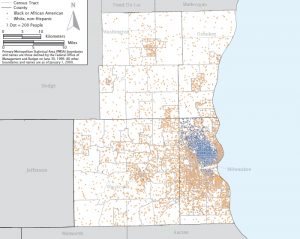Set aside (for the moment) the poll numbers, the partisanship, and the passion and analyze the facts and data.
That was the goal of an “On the Issues with Mike Gousha” program on Thursday, June 14, at Marquette Law School that was a bit unusual. How so? The guests were Charles Franklin, director of the Marquette Law School Poll, and John Johnson, research fellow for the Law Schools Lubar Center for Public Policy Research and Civic Education, but, unlike the large majority of such sessions, particularly involving Franklin, they didn’t have any fresh poll results.
Instead, the goal, as Franklin put it, was to look at the lay of the political landscape, both in Wisconsin and beyond. Results from four special elections so far in 2018 for legislative seats in Wisconsin and from the statewide election of a Supreme Court justice offered the opening insights on current Wisconsin voting patterns. But the discussion expanded to encompass results from more than 300 elections nationwide since the 2016 presidential election and to look at history going back as far as the 1860s.
Franklin and Johnson showed the degree to which Democrats generally had gained ground since 2016 in election results in Wisconsin and nationwide. But Franklin looked at historical trends that show how the party of a sitting president usually loses ground in mid-term elections. What is shaping up for this fall’s elections may (or may not) be more in line with historical patterns than many people think.
One interesting insight: On average, Franklin said, the opposition party has gained 24 seats in the US House of Representatives in mid-term elections. And for the Democrats to gain control of the House this year, they need to gain 24 seats. That means it’s anyone’s guess which party will have the majority in the House after November. Or, as Franklin put it, “uncertainty is the order of the day.”
Franklin looked at the history of the impact on mid-term election of factors such as a president’s popularity, change in the national gross domestic product, unemployment rates, and the results of polling that asks people a generic question (with no candidate specified) about which party they hope will win the upcoming election. Based on history, some of those indicators suggest good prospects for Democrats – and some don’t.
The four special legislative elections in Wisconsin this year, as well as the Supreme Court election (assuming you assign partisan interpretation to it), each showed Republicans doing worse and Democrats doing better than they did in recent elections, Franklin and Johnson showed.
Some suggest that the low turnout in those races reduces the weight that should be put on such trends. Johnson analyzed results of special elections compared to general elections broadly and found that the differences in outcomes between the low turnout and high turnout elections were not as great as many people assumed.
But Franklin said a shift toward Democrats in the legislative elections in Wisconsin this fall wouldn’t necessarily mean changes in which party controls each legislative house in Madison. For example, few legislative elections in recent years have been settled by five percentage points or less, he said, so a five point shift toward Democrats might not change the winning party in many cases.
The first round of results for the Marquette Law School Poll since March is set to be released on Wednesday (June 20). It will include results for the Democratic primary for governor and the Republican primary for a US Senate seat. The pace of campaigning (and polling) will accelerate through the coming months.
But at this point, Franklin said, it was good to pause and look at the bigger and historical perspective.
“The main thing I want to leave you with is uncertainty (about what lies ahead), but I want you to appreciate why we are uncertain and how these different indicators are pushing in different directions,” Franklin said.
To view video of the one-hour conversation, click here. To get information on the poll release program at Eckstein Hall on June 20, click here.

